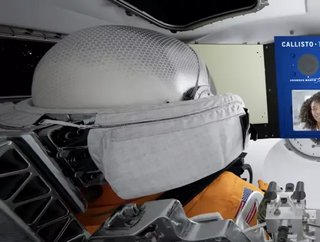Lockheed, Amazon, Cisco partner on AI for Moon mission

When the Artemis I mission, NASA’s new massive deep-space rocket sends the Lockheed-built Orion spacecraft around the moon this spring, it will have a hi-tech companion on board – an interactive tablet dubbed ‘Callisto’.
Aptly named after a companion of the goddess Artemis in Greek mythology, Callisto is a hi-tech touch-screen device that brings together reconfigured versions of Alexa, Amazon’s voice assistant, and Cisco’s teleconferencing platform WebEx.
But, why is Callisto acting as a companion to Artemis on its mission to the Moon?
According to Lockheed Martin, it’s a first-of-its-kind technology being used to assess if future astronauts could benefit from far-afield voice technology, AI and tablet-based video collaboration, and if of benefit, could be used in the future to enable astronauts to be more self-reliant as they explore deep space.
“We envision a future in which astronauts could turn to an onboard AI for information and for assistance and ultimately for companionship,” says Aaron Rubenson, VP of Alexa Everywhere at Amazon. “You could easily imagine astronauts turning to this onboard AI to talk about the status of a subsystem or maybe controlling the lights in the cabin or asking for a particular camera view.”
How will the Callisto technology work?
Three years in the making, the payload features a custom hardware and software integration developed by engineers from Lockheed, Amazon and Cisco, and delivers a ‘human-machine interface’ that includes innovative technology that allows voice-activated Alexa to work without an internet connection, and Webex to run on a tablet using NASA’S Deep Space Network.
To see if these tools work, Lockheed will employ ‘virtual crew members’ on the ground and while Orion is in space, a person in NASA’s mission control centre in Houston will interact with Callisto to test and demonstrate how voice and video collaboration technologies can help astronauts improve efficiency and situational awareness during their mission, providing access to flight status, and the ability to control connected devices onboard Orion.
Video and audio of the interactions will be transmitted back to Earth many times throughout the mission, so engineers can analyse the performance of the onboard systems while also sharing interactions with the public.
This means students, families, space enthusiasts and the general public can engage with and virtually ‘ride along’ with the Artemis I mission. People can follow the mission on Alexa-enabled devices by saying ‘Alexa, take me to the Moon.’
Given that the Star Trek computer was part of our original inspiration for Alexa, “it’s exciting and humbling to see our vision for ambient intelligence come to life onboard Orion,” says Rubenson. “We’re proud to be working with Lockheed Martin to push the limits of voice technology and AI, and we hope Alexa’s role in the mission helps inspire future scientists, astronauts, and engineers who will define this next era of space exploration.”
Enabling communication and collaboration in deep space, and providing the next generation with inclusive and immersive technology, this technological innovation could one day support future crewed missions, providing face-to-face interaction between crew, command centre and loved ones.
Artemis I is a multi-week journey around the Moon
The upcoming flight known as Artemis 1, scheduled to launch sun early 2022 from NASA’s Kennedy Space Center in Cape Canaveral, Florida, is the first test mission in a series of flights planned for NASA’s Artemis program, an initiative to send the first woman and the first person of colour to the surface of the Moon.
A multi-week journey around the Moon and back, Artemis I will mark the inaugural flight of NASA’s next-generation rocket, the Space Launch System (SLS), a huge rocket Boeing has been developing over the last 10 years and which is designed to launch people and cargo into deep space.






